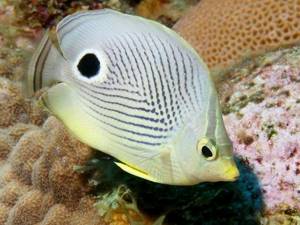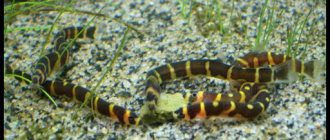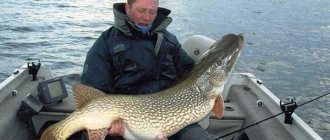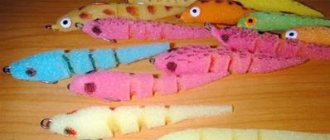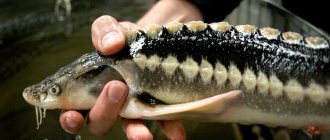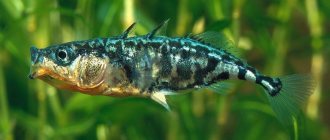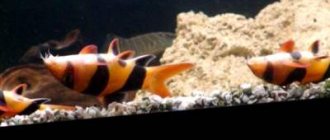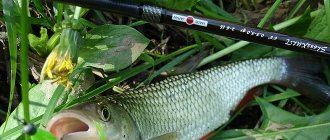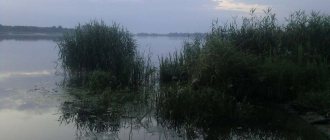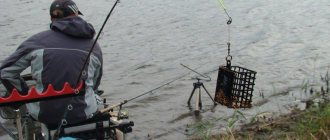Decorated lyrebird angel (lat. Genicanthus bellus)
- family: angelfish
- Habitat: waters of the Indo-Pacific region, Philippines, Palau
- sizes: 15-18 cm
A distinctive feature of the fish is its elongated body with a lyre-shaped tail. The lyrebird has beautiful dark stripes on the sides and blades of its caudal fin, as well as a black or dark brown eye mask. Juveniles and females have brighter and more contrasting colors. Males are also distinguished by the presence of orange stripes.
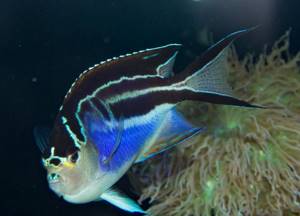
In nature, the lyrebird angelfish is found near the outer slopes of coral reefs, feeds on plankton and gathers in harem groups of 3-7 fish. For conflict-free keeping in the aquarium, you should have one male leader of the lyrebird “family”.
Cockerel
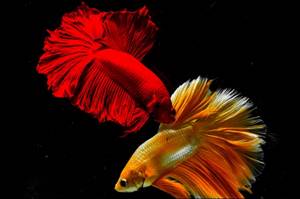
A distinctive feature of Siamese cockerels is not only their quarrelsome temperament, but also their excellent appearance. The body size is on average 5 cm, but if you add the size of the fins of some breeds, the figure can be doubled. Breeders have bred over 70 breeds of cockerels, which differ in color and shape of fins. There are white, pink, red, blue, emerald, and black specimens on sale.
According to the shape of the cockerel's tail, there are:
- deltatails;
- crown-tailed;
- double-tailed, etc.
On a note ! It turns out that everyone can choose a fish to their liking. It is better to keep males alone or in the company of a female. The volume of the aquarium is at least 20 liters.
Parrotfish (lat. Scaridae)

- family: scaridae or parrotfish
- Habitat: Indian and Pacific oceans, Atlantic
- dimensions: 19 cm -1.2 m
Among all the inhabitants of the deep waters, the parrot fish is the most noticeable due to its large size and bright colors - blue, green, yellow, red, brown and orange. Fish may have various combinations of multi-colored spots and stripes. Colors and their intensity largely depend on the sex and age of the fish. Males have a powerful humpbacked growth on the forehead. Parrotfish are loners and hermaphrodites, constantly changing sex. They are territorial creatures, and when night falls they completely hide in a protective cocoon of mucus.
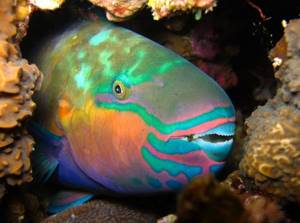
Parrots also have a special tooth structure, which gives their jaw a resemblance to the beak of the bird of the same name. When this fish “eats”, there is a loud crunching sound under the water from cutting and chewing living corals and rubbing teeth on stones. In the fish's stomach, corals, mollusk skeletons and algae are processed into snow-white coral sand, which the parrot fish generously sprinkles on the bottom (up to 100 kg per year).
Glofish
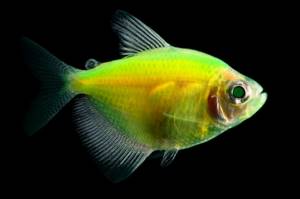
Glofish is the result of the efforts of genetic engineers. The genes of marine coelenterates are introduced into the DNA of the fish, due to which some species have the ability to fluoresce, i.e., biological luminescence. Under an ultraviolet or blue lamp, the glowfish flashes like a neon advertisement. Although the fish have an unusual bright color even without special lighting.
Keeping genetically modified fish is no different from keeping conventional species. In addition, fluorescent genes are passed on hereditarily, and all subsequent generations will also “glow.”
Moorish idol (lat. Zaclus canescens)
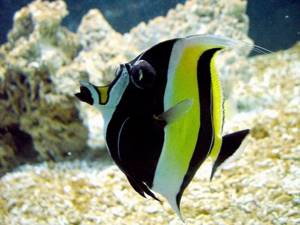
- family: annular
- Habitat: Melanesia, Polynesia, Micronesia, Japan, eastern India
- sizes: 22-25 cm
The Moorish idol is a common inhabitant of coral reefs. In ancient times it was considered to bring happiness and was sacred to the Arabs. But gone are the days when the Arab fisherman released such a fish into the wild, bowing to it goodbye. Now aquarists call the idol a zanklom and keep it at home, although the fish is quite whimsical in feeding.
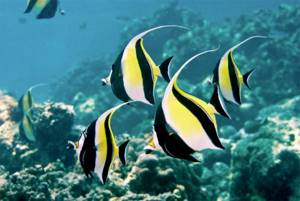
Externally, the Moorish idol is similar to a sklaria, has a flat disc-shaped body and a developed dorsal fin with a long filamentous outgrowth of several rays and spines. Another distinctive feature of the fish is its long snout, reminiscent of a bird’s beak. The bright color of the idol, consisting of alternating black and white-yellow stripes, makes it an unforgettable decoration of the water depths.
Red-striped Mastacembelus (lat. Mastacembelus erythrotaenia)
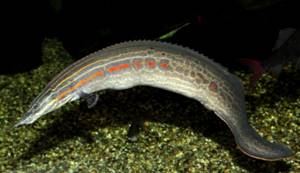
- family: proboscis snouts
- Habitat: Thailand, Burma and Malaysia
- dimensions: length from 0.5 to 1 m, height 6-8 cm
Mastacembelus redstripe or fire eel is a predatory bottom-dwelling fish that lives in slow-moving rivers and lakes with a sandy or silty bottom, densely overgrown with algae. The fish has a long body covered with small scales, large eyes and a pointed movable proboscis on the snout. Mastacembelus is dark brown in color with four fiery red or orange stripes.
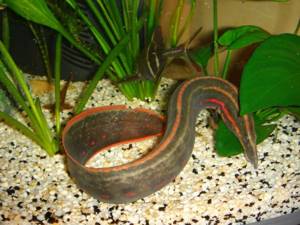
This fish has gained notoriety, both among fishermen and among inexperienced aquarists. On the dorsal fin of Mastacembelus there are spines, with which the nimble fish strives to scratch anyone who tries to pick it up. The thorns themselves are not toxic, but the mucus that covers them is.
Centropyge blue-yellow or bicolor (Centropyge bicolor)
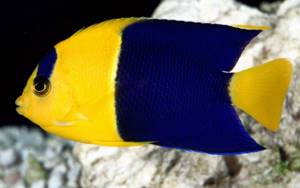
- family: angelfish
- Habitat: from the east coast of Africa to Samoa, southern Japan and New Caledonia
- sizes: 6-15 cm
The blue-yellow or two-colored angel centropyg differs from other centropygs in its large size and characteristic contrasting color. The border of the transition of stripes in the color of the fish is clearly expressed, and sometimes even emphasized by white.
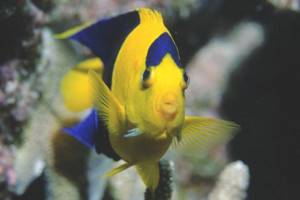
The two-colored angel lives in clear water at a depth of 10-25 m, hiding from dangers among coral reefs and biotopes. Young fish stay solitary, adults - in pairs or small groups. The blue-yellow centropygian feeds on small crustaceans, algae and worms.
Handsome Chromis

This fish is a real pearl among African cichlids. In many countries it is also called the “jewel cichlid.” The body color of the fish is really gorgeous! Her body is bright red, with many bluish-green dots scattered throughout it, shimmering in the reflected light no worse than precious stones. In suitable conditions, chromis can grow up to 15 cm in length. The optimal volume of an aquarium for a pair of fish is at least 60 liters. As for compatibility, Chromis has problems with it: his character, to put it mildly, is not sweet, there is a pronounced territoriality .
Six-banded wrasse (lat. Pseudocheilinus hexataenia)
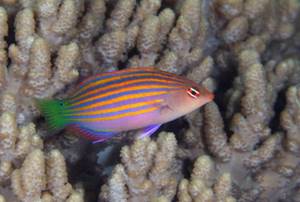
- family: wrasses
- Habitat: Great Barrier Reef, Red Sea, tropical waters of the Indo-Pacific
- sizes: 4-8 cm
The six-banded wrasse or pajama wrasse has an original color with longitudinal stripes of blue and orange. Such “war paint” should warn potential competitors that this area is occupied. After all, the six-banded wrasse is a solitary fish and very territorial.
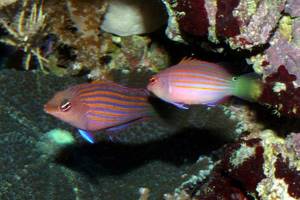
The wrasse is exclusively diurnal, and at night burrows into the sand among crevices. These fish not only look great in aquariums, but also bring considerable benefits by destroying parasitic mollusks and planarians. The wrasse loves a quiet environment and hidden places, so live rocks are installed in their aquariums.
Royal centropyge (lat. Centropyge loricula)
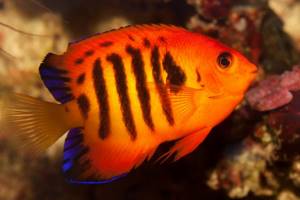
- family: angelfish
- Habitat: southern, western and central Pacific Ocean
- sizes: 7-10 cm
The beautiful and unusually bright color of the small fish, the royal or fiery centropyge, can enliven both the seabed and the home aquarium. In its natural habitat, the fish prefers to live in the outer areas of the reef and in lagoons with clear water. The royal centropigus is characterized by secrecy and caution, so the fish spend most of their time near the shelter. The centropygian diet consists of algae and crustaceans. In the natural environment, this type of fish lives in small harem groups of 3-7 individuals, so it is not recommended to keep several males in an aquarium, since they are aggressive towards each other.
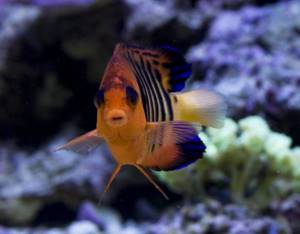
The color of the centropyg is dominated by rich red and black colors, on the sides there are dark vertical stripes, and the fins of adult individuals are decorated with a bright blue border and longitudinal blue strokes.
Lionhead goldfish (Carassius auratus lionhead)
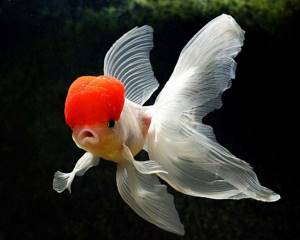
- family: carp
- Habitat: Japanese Islands, bred through selection
- sizes: up to 20 cm
Lionhead is one of the so-called “Goldfish”. It has a short, rounded body, no dorsal fin, and in the area of the gill covers there are growths of compacted skin that look like a raspberry or a lion's mane. The growths sometimes reach large volumes, covering the fish’s already small eyes. The most common colors of lionheads are gold, snow white and orange-red.
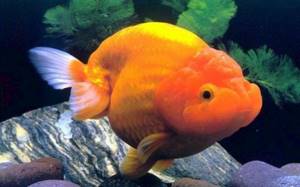
Lionheads are easy to care for, friendly and get along well with their aquarium neighbors. They eat everything, but have a tendency to overeat, so the only task of their owner is not to overfeed the beautiful pet.
Pearl gourami
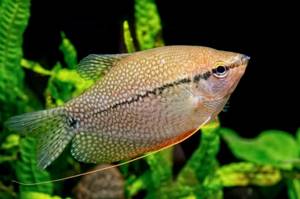
One of the most beautiful aquarium fish. Gourami has a silvery-purple body with numerous small spots resembling pearls. During spawning, the fish literally burn! Modified pelvic fins, resembling long sensitive threads, help the fish explore the world around them.
The body size of pearl gourami reaches 12 cm. The fish do not need forced aeration , because they can breathe atmospheric air (you just need to provide access to the surface).
Mandarin duck (lat. Synchiropus splendidus)
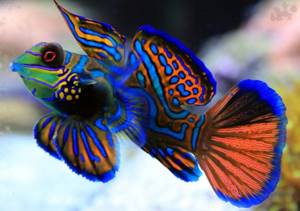
- family: lyreaceae
- Habitat: Western Pacific Ocean
- sizes: 5-8 cm
The unusually bright coloring, mysterious patterns on the sides and fins, as well as natural slowness and impressiveness gave this small fish a resemblance to the Chinese nobles and the name Mandarin duck. These miniature and undoubtedly beautiful fish are a desirable acquisition for any aquarist, but caring for them in captivity is quite difficult and troublesome.
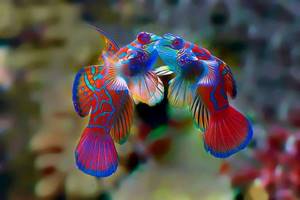
The natural habitat of mandarin ducks is coastal reefs, muddy or sandy sea soil. Their favorite delicacy is amphipods and gastropods, but, in principle, any small representatives of crustaceans, invertebrates, as well as fish eggs are suitable for them.
Royal angelfish (lat. Pygoplites diacanthus)
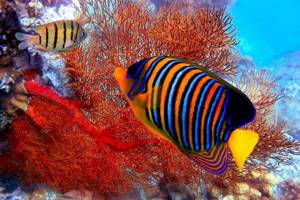
- family: angelfish
- Habitat: Red Sea, Indo-Pacific region and Tahiti
- sizes: 10-25 cm
The body of the king angelfish has wide vertical blue-white stripes with dark edges. These fish also have a very beautiful dark blue fin with multiple blue splashes.
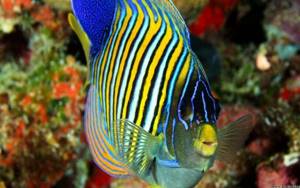
The tropical sea fish, like most of its fellow species, has chosen habitats with abundant coral vegetation and multiple shelters. The king angelfish prefers to live alone, but can sometimes acquire a mate. The fish feeds on ascidians and sponges and can live up to 15 years. Due to the non-aggressive nature of the king angelfish, it gets along well with most aquarium inhabitants, but requires a lot of space and privacy.
Red neon
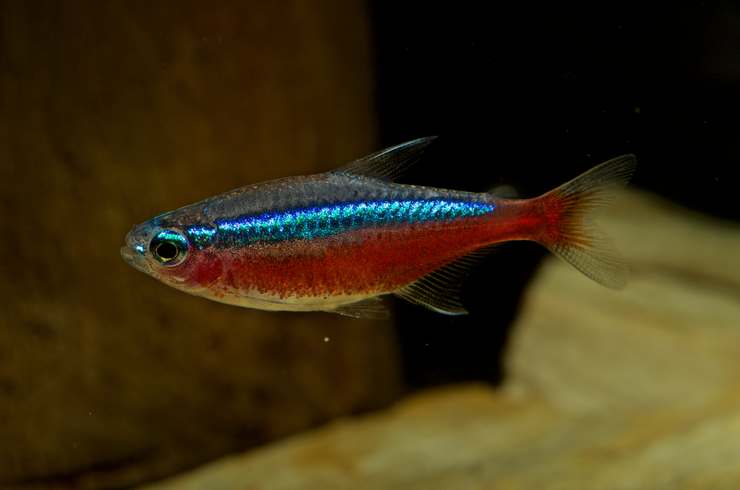
Red Neons are often found in aquascapes , as these small fish are the most beautiful representatives of the Characin family. The peculiarity of red neons is 2 red stripes running along the entire body (one is bright red and the other is blue, with a characteristic neon glow).
The body size does not exceed 5 cm. The fish are kept in schools, and the larger the group, the better it looks. Neons get along well with peace-loving fish and living plants.
Triggerfish Picasso rectangular (lat. Rhinecanthus rectangulus)
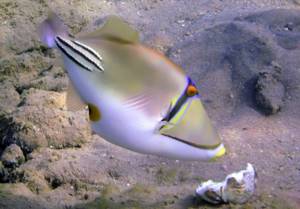
- family: triggerfish
- Habitat: Indian-Pacific region
- sizes: up to 30 cm
The Picasso rectangular triggerfish is a very powerful fish that looks like an oval. The color of these fish has several variations, but all of them are extremely beautiful. In most cases, the head, back and middle of the abdomen are white, with a black stripe widening at the base of the fin. The eyes of the Picasso triggerfish are very specific because they are located very high, almost in the middle of the fish’s body, and can rotate independently of each other.

Fish with an extraordinary appearance also have a rather complex character. When calmness is replaced by unexpected outbursts of rage, things get tough for both the fish caught “under the hot fin” and the fragile details of the aquarium furnishings.
Princess of Burundi
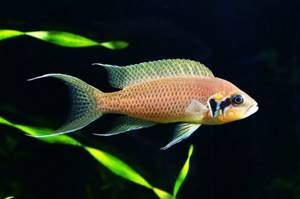
Princess of Burundi (another name is Neolamprologus Brishara) lives in the waters of Lake Tanganyika in Africa. It was not by chance that this peace-loving fish was named princess. It has a very elegant elongated body, a lyre-shaped tail and veil fins with pointed tips. The body size does not exceed 10 cm. To keep a group of neolamprologus, you need an aquarium with a volume of 130 liters or more.
The Princess of Burundi's coloring may seem modest, but if you look closely, you'll notice some interesting details. The scales of the fish are pinkish-white, with yellow speckles. The mosaic pattern at the bottom of the head has a blue tint, and a black stripe runs from the gill cover to the edge of the eyes. Another feature is the blue edging of all fins.
Tetraodon (lat. Tetraodon)
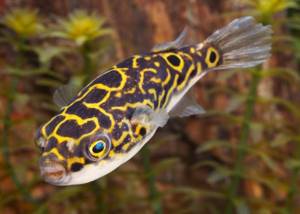
- family: pufferfish
- Habitat: Africa, South and Southeast Asia
- sizes: 5-67 cm
Tetraodon is one of the most spectacular, but most controversial and unpredictable inhabitants of freshwater reservoirs and aquariums. Tetraodons have smooth skin, rounded shapes, moist pupils and a trusting look. They are cute and funny. They are also poisonous and dangerous, and are related to puffer fish.
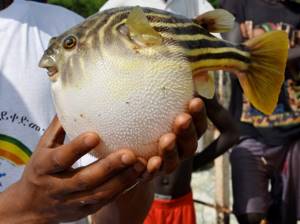
Tetraodons were never of interest to breeders, so they retained the naturalness of the species. They are distinguished by color, size and degree of aggressiveness. The color range ranges from olive green to brown, and tetraodons are distinguished by their unique pattern. Fish have only 4 teeth, but they are quite sufficient for crushing shellfish shells. The main “trick” of tetraodons is the ability of their pear-shaped body to inflate into a ball and bring the spines that replace scales into a vertical state.
Discus
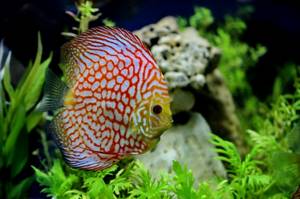
Discus are unusual South American cichlids that are distinguished primarily by their round shape and many color variations. These fish first appeared in aquariums in the middle of the last century. It is difficult to keep them, however, the variety of breeding forms is simply eye-opening!
On a note ! Discus fish behave imposingly, like aristocrats, and therefore they are also called “kings of the aquarium.” The body length reaches 25-30 cm. They are kept in schools in aquariums with a volume of 400 liters or more. Discus fish are not very hardy; they are very sensitive to feeding and water parameters.
Royal blue surgeon (lat. Paracanthurus hepatus)
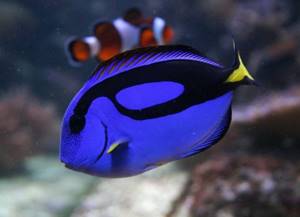
- family: surgical
- Habitat: Indo-Pacific
- sizes: 15-30 cm
One of the rarest species in the marine aquarium, the royal blue tang, became extremely popular after the release of the cartoon “Finding Nemo.” These fish have a laterally compressed body, long fins and a steeply sloping forehead. The blue coloring with black swirls on the body, as well as the bright yellow accent of the fin, give the Royal Surgeon a stunning appearance.

Royal blue tangs get along well with all types of aquarium fish, but not with their relatives. It’s just that these fish are loners and create harem schools exclusively for the mating period. Royal surgeons have sharp, scalpel-shaped spines that can extend and retract. If there is more than one fish in the aquarium, the spines turn into an effective weapon in disputes over territory.
Frontosa

Frontosa is one of the most charming cichlids of Lake Tanganyika. The body length can reach 30 cm, and therefore the volume of the aquarium for keeping must be at least 300 liters. The frontosa has a large and massive body, and a fatty growth is located above the head (in males it is larger). But the most attractive thing is the stunning coloring, which is an alternation of wide dark and light stripes. There are several geographical species , differing in color intensity, location and number of stripes.
Note ! Frontoz's neighbors in the aquarium should only be comparable species of fish, since everything that fits into the mouth will most likely be eaten.
Seahorse (lat. Hippocampus)
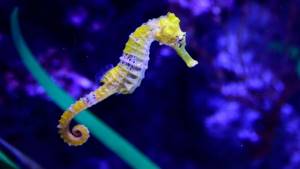
- family: needle
- Habitat: tropical and subtropical seas
- sizes: 2-30 cm
The seahorse is a fish with the most interesting body shape that exists today. Although there are more than 50 species of skates in the world, anthropologists have only been able to study 32 of them. The appearance of these unique creatures has the ability to completely adapt to their habitat. For this, the sea “chameleon” only needs a few minutes. The body of the seahorse is decorated with multiple spines of different sizes and ribbon-like leathery outgrowths. The fish's eyeballs can move independently of each other, increasing viewing angles.
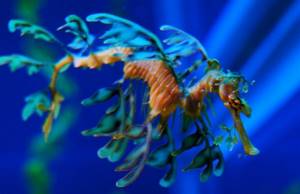
Seahorses prefer to live in shallow, swampy or sandy water surroundings. They lead a solitary, sedentary lifestyle, clinging to algae and corals with their tails and catching plankton floating by. What makes this fish species mysterious is the reverse distribution of roles between male and female in the hatching of offspring.
Tulle apogon or Pterapogon cauderni (Pterapogon kauderni)
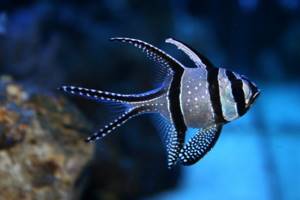
- family: angelfish
- Habitat: coastal waters of Bangai Island
- sizes: 5-8 cm
The tulle apogon, which can also be found under the name "Cardinal Kauderna Fish", lives exclusively near the shores of Bangai Island. The fish has a silver body with small white spots, intersected vertically by black stripes. White spots are more clearly visible on the fins of the apogon and give it a particularly picturesque appearance, reminiscent of a bird or butterfly.
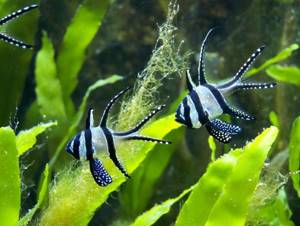
Tulle apogons often live in flocks, but with age, males begin to gravitate toward territoriality. In this regard, aquarists are recommended to keep apogons in large aquariums with an abundance of stones and alone. They don’t touch peaceful neighbors, they don’t eat polyps, but they gobble up small shrimp with a bang.
Turquoise Akara
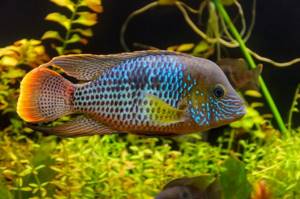
One of the most beautiful cichlids in South America. Her bluish-green scales seem to be surrounded by a luminous halo. And near the head there are turquoise stripes and spots. The dorsal and anal fins are strongly elongated. A yellow or white edging is clearly visible on them (as well as on the tail). Males often have a fatty growth on their heads. Another name is “green terror”.
On a note ! For maintenance you need an aquarium with a volume of at least 300 liters (if it is a species one). Acara is a territorial fish, unable to get along even with species of similar size.
Clownfish (Amphiprion)
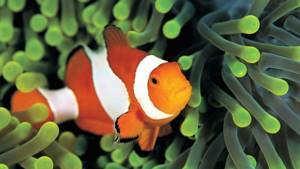
- family: pomacentric
- Habitat: Indian and Pacific Oceans
- sizes: up to 8 cm
Another illustration for the cartoon “Finding Nemo” and the prototype of one of the main characters – the clown fish. Fish of this species have very attractive colors of orange, black, white and other colors. They are friendly, undemanding and great for captivity.
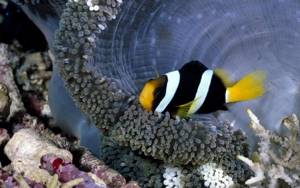
A small fish with an original color in its natural habitat is accustomed to living in close connection with marine organisms such as sea anemones. The clown fish is not afraid of the toxins of this invertebrate and forms a symbiotic pair with it. The fish helps the sea anemone breathe, and the poisonous tentacles of the sea anemone serve as reliable protection for the brightly colored and poorly swimming clown fish. It is possible to keep a clownfish in an aquarium without an anemone, but this violates the natural partnership.
Afiosemion
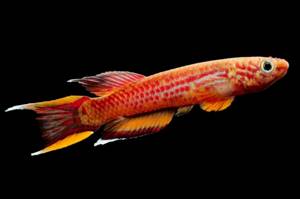
Afiosemion are representatives of spawning carp-toothed fish, better known as killifish. Currently, about 90 species have been described with an unusual variety of colors - from fiery red to sky blue. In nature, these fish live in extreme conditions. Temperature changes, constant changes in water parameters and even complete drying out of reservoirs have made these fish hardy, and their life is inextricably linked with the rainy and dry seasons.
Radiant lionfish (lat. Pterois antennata)
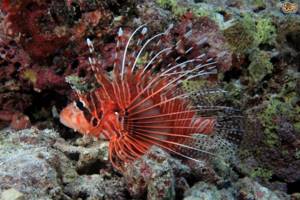
- family: scorpionfish
- Habitat: waters of the Indian and Pacific Oceans, the Red Sea and the Arabian Sea
- sizes: up to 24 cm
The bright color of the radiant lionfish is a warning signal for its enemies, because the sting of this fish is very unpleasant. The lionfish has a pronounced dorsal fin, consisting of 12-13 hard poisonous rays. The composition of the poison is identical to cobra toxins, but is contained in lower concentrations. The fins connected by membranes give the radiant lionfish special beauty. Thanks to this, the swimming lionfish turns into something like a clot of flame.
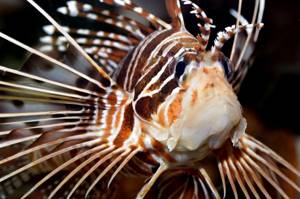
The beautiful lionfish can be found in shallow lagoons and on reef flats. The lionfish is nocturnal. The predatory beauty feeds on shrimps and crabs, and occasionally can attack small fish.
Betta fish or betta fish (lat. Betta splendens)
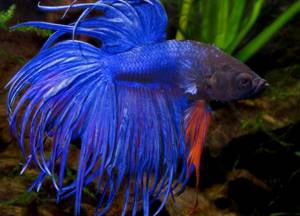
- family: macropods
- Habitat: Southeast Asia
- sizes: 4-6 cm
The most popular aquarium fish in its natural environment is found in freshwater ditches, rivers and streams of Southeast Asia. These funny fish were first noticed at the beginning of the 19th century by the inhabitants of Siam, who drew attention to their aggressive nature. The cockerels were transferred to the imperial court, where they were first studied by scientists, and later began to be used in “fish” fights.
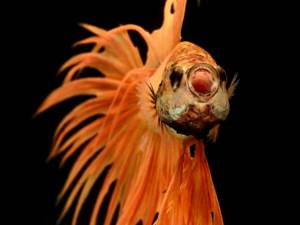
Cockerels are distinguished by multiple variable colors and the ability to change the color of scales depending on the external environment and the internal state of the fish. Wild cockerels look less impressive, they have shorter fins and an olive color. Betta fish can breathe through gills and atmospheric air, are easy to care for and are suitable for beginner aquarists.
Guppy
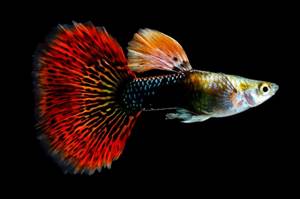
Guppy is the most famous aquarium fish, which does not lose popularity, despite its small size and long history. This is explained, first of all, by the unpretentiousness of guppies, ease of reproduction and a wide variety of colors.
It is difficult to count the number of breeding forms of guppies. There are varieties that differ in the color of the body and caudal fin. The shape of the tail also varies.
Imperial angel (Pomacanthus imperator)
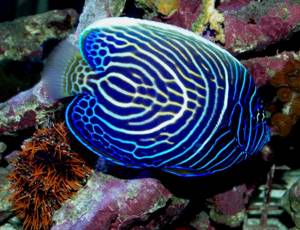
- family: angelfish
- Habitat: tropical waters of the Pacific and Indian oceans from the Hawaiian Islands to the Red Sea
- sizes: up to 40 cm
Of all the members of the angelfish family, the imperial angelfish is the most spectacular. At the same time, it is extremely rare in wildlife. The imperial angel has an oval, elongated, laterally compressed body with an elongated mouth like a beak. These fish have the ability to change color with age, and dramatically: from a dark blue color with white and lilac stripes in youth to a soft blue-green color with golden stripes in adulthood.
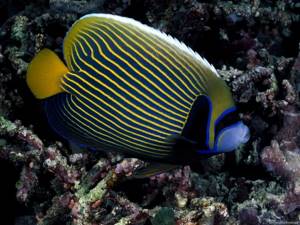
Imperial angels are very popular among aquarists. But you should know that these bright fish are selfish and prone to aggression. If the owner of imperial angels does not want problems, he should get a large aquarium.
Lyalius
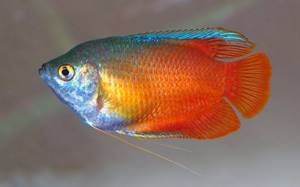
This beautiful fish lives in the rivers of India. Adults grow up to 6 cm in length. Transverse blue-green and red stripes alternate along the oval body. Females are greyish-green with paler stripes. These representatives of the macropod family mainly feed on algae. Many aquarists like to breed Lalius.
Interesting: Unexpectedly dangerous animals - list, names, why they are dangerous, photos and videos
Butterflyfish (Chaetodontidae)
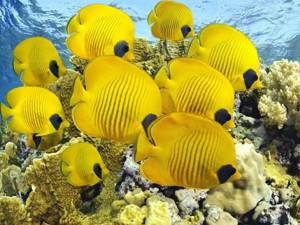
- family: butterflyfish
- Habitat: Indian and Pacific oceans, Atlantic
- sizes: 7-30 cm
The family of the most colorful and beautiful sea fish - butterfly fish - are the main calling card of coral reefs, and there are more than 130 different species. They live in coral reefs and rocky outcrops of the coastal strip, choosing one area to live for a long time or for life. Butterfly fish are loners and do not form schools or aggregations. They lead a diurnal lifestyle, feeding on invertebrates and parasites.
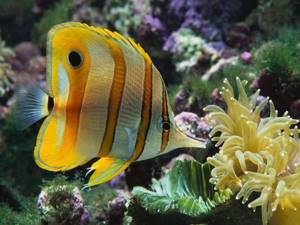
The characteristic features of butterfly fish are a high, laterally compressed body, an elongated rostral part of the head into a tube, and an undivided dorsal fin along the entire body. The main colors of the coats combine black and yellow, black and silver, as well as red, blue, orange spots on a yellow background. Often the pattern on fish is similar to an eye, which helps butterflies hide among colorful reefs to escape predators.
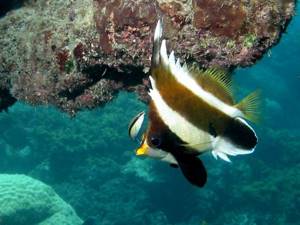
Almost none of the reef aquariums can do without butterfly fish, because they are beautiful and conflict-free.
